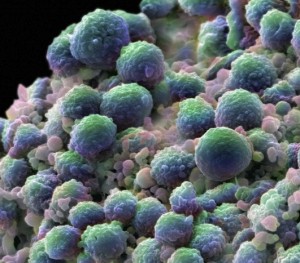 Microbes have abilities to make decisions, communicate, and solve problems (See post). In fact, recently it has been shown that large numbers of microbes in the human body (ten microbes for every human cell) are in constant communication with human cells and provide many functions for normal human life. These functions include defending against dangerous species, boosting the immune system, protecting from autoimmune disease, helping maintain appropriate weight, helping avoid stress, and making babies healthier.
Microbes have abilities to make decisions, communicate, and solve problems (See post). In fact, recently it has been shown that large numbers of microbes in the human body (ten microbes for every human cell) are in constant communication with human cells and provide many functions for normal human life. These functions include defending against dangerous species, boosting the immune system, protecting from autoimmune disease, helping maintain appropriate weight, helping avoid stress, and making babies healthier.
While microbes appear to have a type of cognition, the neuron has been  observed to be vastly more complex with its own intelligent activity, an entire civilization by comparison to a microbe (post on complex neuron). While the neuron rapidly builds extremely complex axons and dendrites in response to mental events, it has a community of mitochondria, which were previously independent microbes, traveling throughout the cell providing energy wherever needed (see post). Through communication within the neuron, these partially independent microbe-like mitochondria are able to know where they are needed to provide the necessary energy for all of the building and rebuilding in the constantly changing neuron (see post)
observed to be vastly more complex with its own intelligent activity, an entire civilization by comparison to a microbe (post on complex neuron). While the neuron rapidly builds extremely complex axons and dendrites in response to mental events, it has a community of mitochondria, which were previously independent microbes, traveling throughout the cell providing energy wherever needed (see post). Through communication within the neuron, these partially independent microbe-like mitochondria are able to know where they are needed to provide the necessary energy for all of the building and rebuilding in the constantly changing neuron (see post)
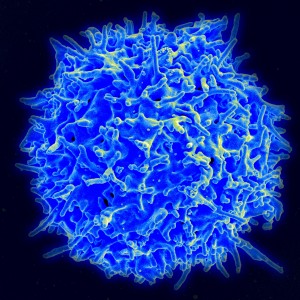 If microbes and neurons show forms of cognition, what about other cells in the human body? All human cells appear to be in elaborate communications with cells in their own organs, signals from hormone producing organs, neurons, as well as the huge number of microbes. Certainly immune cells demonstrate very complex communication and decision-making similar to microbes and neurons.
If microbes and neurons show forms of cognition, what about other cells in the human body? All human cells appear to be in elaborate communications with cells in their own organs, signals from hormone producing organs, neurons, as well as the huge number of microbes. Certainly immune cells demonstrate very complex communication and decision-making similar to microbes and neurons.
What about the emperor of all cells, cancer? How intelligent is the devastating cancer cell, and its growing community of cells?
This post will first briefly discuss intelligent behavior in immune cells, and then focus on cancer cells.
Immune Cell Intelligence
Immune cells, like bacteria, show great cognitive abilities to recognize foreign molecules, to rapidly create an army of specific cells to fight an invader when necessary, and to travel in and around blood vessels, organs, and lymph nodes. To perform these elaborate functions, there is a vast communication network that dwarfs the communication of microbe colonies, although immune cells are in constant communication with the 100 trillion microbes in the human body. Unlike the  highly specialized cells of the human organs these immune cells maintain the fetal ability to rapidly change into many new very specific types of cells. They are also mobile, migrating throughout the body wherever they are needed.
highly specialized cells of the human organs these immune cells maintain the fetal ability to rapidly change into many new very specific types of cells. They are also mobile, migrating throughout the body wherever they are needed.
Immune cells show advanced abilities that imply a form of cognition. An important recent example is that the movement strategy of immune T cells when hunting bacteria and viruses is similar to the way that predator animals hunt. T cells are critical to fighting many very important infections including Toxoplasma Gondi, the bacteria known to affect neurons and human behavior. When infected, the brain produced a signal molecule, CXCL10, which triggered more T cells. But, after being notified of the infection the T cells didn’t follow a specific movement related to this chemical. Instead there was a pattern of many short steps with pauses and then a long run. The cells took small steps looking for the parasite, then pause and then move quickly in one direction. Tuna, sharks, penguins, monkeys, and bees also use this movement strategy when hunting. It is especially effective because the parasites know how to hide from the T cell.
Immune cells demonstrate many other very unusual abilities. One involves neutrophils, the main defense against infection from bacteria. One of their extraordinary mechanisms of movement has recently been discovered. It appears that neutrophils use a lasso, which is thrown forward to hold onto the side of the blood vessel in order to move against the flow of blood when necessary. (See video showing this very unusual ability of the neutrophils)
But, perhaps, the cancer cells are even smarter.
The Emperor Cell
The current theory of how cancer starts is through a set of random mutations, which stimulate an abnormal state with increased multiplication of cells. As the cells rapidly multiply more mutations occur allowing them to evade regulation and to
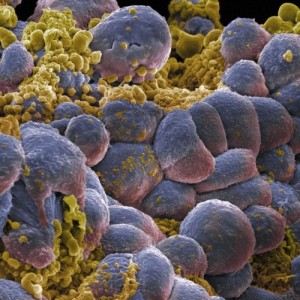
spread into other tissue. Recently some cancers have been shown to need as many as ten different mutations. It is not clear that this is the whole story, however. Another study showed that of a hundred mutations in a cancer, only two were related to the cancer and the rest were related to aging.
Recently, scientists have questioned whether it is just the random mutations that cause cancer. There is reason to believe that it may be equally related to the constant battle between the cellular self-editing mechanisms and the errant cells that appear through the mutations and many other processes. Another post discussed the extremely complex self editing, and proofreading in the duplication of DNA for new cells. It may be defects in that process that allow cancer cells to take hold.
Cancer cells have very advanced editing properties such as rapidly fixing cellular damage and avoiding damage to telomeres, the tips of chromosomes that determine how many times a cell can divide.
Their multiplication is also highly unusual. A recent study showed that a cancer cell, in its cramped environment inside the body, instead of dividing into the ordinary two cells, could divide into five cells at once. Ordinarily cellular division is highly regulated to allow exact duplicates of all the complex parts of the cell.
Today, as the 98% of the genes, which were considered junk, are now examined, it has been demonstrated that there is a vast regulatory network including many kinds of small RNA molecules that appear to play critical roles in normal cell function and in cancer development. Although the small RNA’s appear to have a very important role in creating cancer, there are now many other factors that clearly influence this process. Important cancer producing factors include modifiers of the chromatin which protects the DNA including histone modifiers, histone genes, and DNA methylation.
The complexity is greatly increased by the fact that 90% of cells in our body that make molecules are microbes living in symbiosis with human cells. There is massive communication between the molecules produced by the microbes and the human cells including the cancer cells. These messages also seem to be involved in the production cancer.
One of the major signals that stimulate or repress DNA is the microRNA, which have vast influence over the entire cell’s functioning. While each is very tiny, microRNA’s function is so complex that a recent study demonstrated a large system of microRNA gene regulation involving 248,000 different interactions of the different microRNA’s. This system, called the mPR network, involves 500 genes of which dozens or hundreds of genes can work together through these microRNA signals both to stimulate or block cancer.
In one example of this network, a subset of 13 different genes worked together to stop a critical cell function and help create cancer. But, many other genes also interacted with these 13 genes producing different genetic variations of the same glioblastoma brain cancer. Therefore, an enormous number of signals were interacting to help produce or to attempt to stop the cancer.
MicroRNA
The microRNA molecules are very small, 18 to 25 nucleotides long, where a gene is thousands or millions of nucleotides long. Increasingly, many different types of small RNA molecules seem to be major regulating agents in the extremely
 complex interplay of DNA being stimulated and repressed in their task of making proteins. It is now known that these small pieces of RNA can also function by themselves as cancer producing genes. They can also change the differentiation of cells to form cancer cells by affecting the cells DNA directly. They normally work as cancer suppressors in the editing function (see Cellular Self Editing). In some cancers the ordinary microRNA’s that keep normal function are underutilized. In some the RNA becomes the director of abnormal activity. These microRNA’s also are critical to allow metastasis. MicroRNA’s are known to be very important in a wide variety of cancers, including lung, breast, stomach, pancreas, colon, brain, ovary, bladder, and many blood cancers, such as lymphoma, and leukemia.
complex interplay of DNA being stimulated and repressed in their task of making proteins. It is now known that these small pieces of RNA can also function by themselves as cancer producing genes. They can also change the differentiation of cells to form cancer cells by affecting the cells DNA directly. They normally work as cancer suppressors in the editing function (see Cellular Self Editing). In some cancers the ordinary microRNA’s that keep normal function are underutilized. In some the RNA becomes the director of abnormal activity. These microRNA’s also are critical to allow metastasis. MicroRNA’s are known to be very important in a wide variety of cancers, including lung, breast, stomach, pancreas, colon, brain, ovary, bladder, and many blood cancers, such as lymphoma, and leukemia.
The study of RNA has become monumentally complex. As well as the well-known ribosomal RNA, the transfer RNA and the messenger RNA some of the many current classes of RNA’s include:
microRNA
lincRNA – large intervening non coding RNA;
siRNA – small interfering RNA
snoRNA – small nuclear RNA
piRNA – from Piwi interacting RNA (Piwi from P-element induced wimply testis)
rasiRNA – repeat associated small interfering RNA
Bacteria and virus cancer
While the exact mechanisms have been unclear, it is known that certain viruses stimulate cancers. Because of this, vaccines against specific viruses help prevent cancer.
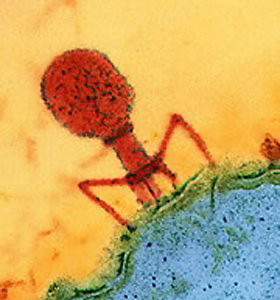
Viruses survive by injecting their genetic material into cells. One class of viruses injects its genetic material into the victim’s DNA, incorporating it permanently into the cell. Somehow, viral genetic material interacts with the cell to form a cancer cell unbound by the restrictions and limits of usual cells.
But, as with all areas of molecular biology, it is not that simple. Recent developments confuse the picture.
A huge number of bacteria and even more viruses surround each of our cells. These microbes are so much a part of our daily function that their combined genetic pool is at least a 100 times larger than our own. This means that a large percentage of the active molecules inside of our body come from bacteria and viruses. The microbes’ proteins can send messages to our cells that help to create cancers. These bacteria also send their own microRNA into the mix of signaling particles. Even further complicating this picture is the fact that microbes routinely use virus like particles or viruses themselves to send pieces of DNA to large numbers of other microbes. This sharing of genes, called horizontal gene transfer (HGT), can include fragments, whole genes and multiple genes that can determine a new function such as all of the genes for photosynthesis.
Cancer Communication and Decision-Making
Critical to the formation and survival of a cancer is the ability of the cancer to change the direction of the metabolism and avoid the self-editing regulation processes that ordinary destroys abnormal cells.
Many cells in the human body cooperate in communication with the cancer cells. The cells that form the structure of the organs, fibroblasts, cooperate with cancer cells to build new cancer organs. Immune cells are fooled to give cancer growth factors behaving as if they were healing a wound. These factors also increase blood vessels.
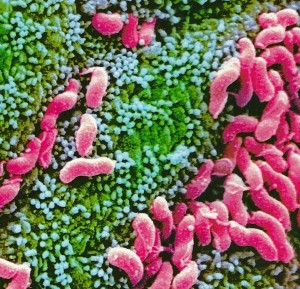
Communication is also occurring between the specific microbes living in particular regions. For example, it has been recently shown that each human and animal has specific communities of microbes that have specific abilities. In Japan a microbe has allowed for digesting sushi wrappers. The microbe that causes ulcers, Helicobacter Pylori, is also critical to normal humans. As it is eradicated in the treatment of ulcers, there has been a rise in stomach cancer. The microbe is now known to be critical to avoid the stomach cancer. Many other cancers are either stimulated or repressed based upon the specific microbes available.
Cancer Warning Signals About Viruses
Just as microbes communicate with other microbes, cancer cells communicate with other cancer cells. Both communicate with all the other
cells in the human body. One example is a brain tumor that is infected with a virus. Just as plants and microbes mount a defense when given warning, this cancer cell sends out a protein called CCN1, which stimulates a rapid response to kill viruses. This response includes stopping the virus from multiplying and stopping the virus’ ability to kill cells. In fact this cancer communication system against viruses might be a good technique for virus treatments.
Recent studies have shown that while there are ten microbes in the human body for each human cell, there are 100 viruses for each human cell (10 trillion human cells, 100 trillion microbes, and 1000 trillion viruses in the human body).
Targeted treatment
It was recently found that at the beginning of a cancer there are a small number of cancer cells already resistant to certain future treatments. This is like the existence of a small number of antibiotic resistant microbes in a large community of microbes. Specific treatments have been recently devised which target a specific cancer cells ability to grow and spread. The older chemotherapy treatment kills any cells at random. But, in the targeted treatment, resistant cancer cells arose months later.
It was found that in a colon cancer a very small number of resistant cancer cells (one in a million) existed before the targeted treatment. But, even that one cell could start a new cancer when all the others were killed, just as one resistant bacterium can rapidly build an entire new colony. Therefore, this study showed that both treatments must be used at once, the targeted for most of the cells and chemotherapy for the very small number of already resistant cells.
Cell Self Editing Versus Emerging Cancer Cells
There appears to be a constant battle occurring in normal life between potentially cancerous cells and the intelligent cellular editing process. Once the cancer is started the battle continues in even more complex ways between many different type of cells, microbes and viruses. The study that showed a hundred mutations but only two related to cancer, implies how important the editing process is. In aging there are more mutations, but more importantly the editing processes has become less accurate as aging occurs. This is also consistent with the finding that in targeted treatment resistant mutations existed all along.
Cell Migration
When cells in the body are born they must move to their appropriate place in the organs and then take direction as to their appropriate function. Evolving into the specific cells, such as liver, kidney, skin, is called differentiation. When this differentiation process goes awry cancer cells can be created.
 Recently a mechanism was discovered for neurons’ migration that is also very important for cancer cells. It is considered surprising because the critical signaling molecule, N-cadherin, which is on the surface of the neuron or cancer cell is a major way that cells stabilize their positions with other cells, a glue like molecule that helps adhesion of cells in a structure. It was recently found that N-cadherin interacts with a molecule Reelin that is critical for neuronal movement, and probably cancer’s movement.
Recently a mechanism was discovered for neurons’ migration that is also very important for cancer cells. It is considered surprising because the critical signaling molecule, N-cadherin, which is on the surface of the neuron or cancer cell is a major way that cells stabilize their positions with other cells, a glue like molecule that helps adhesion of cells in a structure. It was recently found that N-cadherin interacts with a molecule Reelin that is critical for neuronal movement, and probably cancer’s movement.
The human cortex forms very specific horizontal layers of neurons with very specialized functions. These neurons are added to the outside of the growing column by passing through the existing cells. What is strange in this migration is that the neurons pass through many cells in a seemingly purposeful way, then enter a region of mainly fibers with few cell bodies where they appear to have no direction, going up, down, and sideways at random. The neurons then, apparently by accident, leave the confusing region and enter a column of very organized cells where they again rapidly move in the exact path to the outside and join the column. Recent research shows that Reelin, made in the top most layers of the neurons, seems to change the wandering neuron’s membranes to allow them to find and respond again to  the migration signals. The critical molecule that alters the membranes of the cell to respond to Reelin is the N-cadherin. It is thought that cancers have this same migratory mechanism.
the migration signals. The critical molecule that alters the membranes of the cell to respond to Reelin is the N-cadherin. It is thought that cancers have this same migratory mechanism.
Another mechanism for migration in cancer was recently shown to be a communication signal produced by the cancer cell that makes the blood vessels permeable, that is, allows holes in the blood vessels that the cancer cells can use to travel in the blood to other organs. These chemical messengers, called chemokine CCL2, activate a receptor on the blood vessel cells opening passage for the cancer cells.
Intelligent Cancer Cells
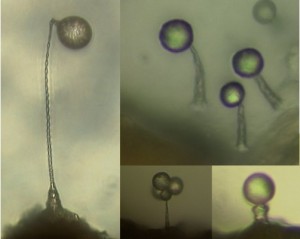
Cancers are much more intelligent than previously thought. For instance, they manipulate normal functions of blood and immune cells to their advantage. At times, the cancer behaves like an organism rather than a group of rebel individual cells. This is similar to microbes that can join together into a fruiting body, behaving as if they are a multicellular organism, and then separate again into individual cells (see post Social Microbes). For microbes and cancer cells to behave as a community of cells, or as a multicellular organism, there is elaborate communication and decision-making. It is not known if cancer cells use gene transfer with virus like particles or viruses, as most microbes do.
Just like other cells and organisms, we have to wonder how much the cancer cell and organism knows? Does it, like all the other levels of organisms that we have investigated, also have some form of mental capacity?